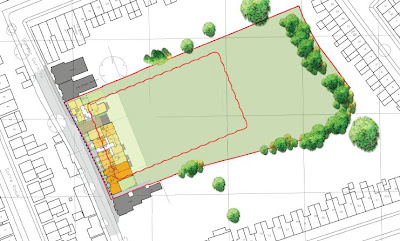Gondar Gardens – first appeal nears conclusion
The tale of the proposed development of the Gondar Gardens reservoir site is a lengthy one. In essence, a couple of years ago, developers Linden Wates put forward a plan that would have seen the disused site turned into a series of semi-sunken homes, that became known as the Teletubby development. Planning permission was refused, partly due to the presence of slow worms on the site.
 |
| Computer image of original plans |
A second, less controversial development was then put forward that kept much of the green space intact, but still added new housing on the street. This too was refused.
 |
| Artist’s impression of second proposal |
While the second proposal was being considered, Linden Wates was appealing the first decision. That appeal opened in May but was adjourned after three days. The inquiry reconvened last week, and the hearing concluded yesterday.
Here’s the assessment of how the appeal has gone from the perspective of the Gondar & Agamemnon Residents Association (GARA):
Back in May, both Camden and GARA gave evidence as to why the refusal should be upheld, and were cross-examined at length. Linden Wates started to give their evidence.
This week, the inquiry reconvened. Linden Wates gave detailed evidence and were cross-examined by Camden’s barrister and GARA’s barrister.
On Thursday, there was a lengthy examination of opposing experts’ views about the state of the reservoir structure and its likelihood of partial or total collapse; and a debate about Linden Wates’ approach to affordable housing (i.e., paying for it to be somewhere else).
Almost all of Friday was spent with Linden Wates’ planning consultant, with arguments about the relative merits of different aspects of planning policy. That might sound interminable but it goes to the heart of the matter – does the protection of being Open Space and a Site of Nature Conservation Interest outweigh the developer’s argument that the structure itself is ‘previously developed land’?
Add in arguments about whether the new National Planning Policy Framework promotes development, or protects land of high environmental value, and you have the opportunity for some lively debate, some of it rivalling any West End theatre production (OK, only in parts).
Also on Friday, local resident Mark Stonebanks made an excellent contribution, challenging LW’s competence in areas of traffic and parking, design, and drainage.
Monday – the final day – started with a visit to houses on all four sides of the site. The inspector seemed to expect the good views from Gondar Gardens and the less good views from Agamemnon Road (obscured by trees); but he appeared surprised at the extent of views from Hillfield and Sarre Roads.
We returned to the inquiry and heard an impassioned, yet controlled statement from Hugh McCormick [Ed: I don’t know who he is]. Linden Wates’ barrister declined to cross-examine. There followed some haggling over conditions / Section 106 matters to be imposed “should the appeal be successful”. Linden Wates and Camden had pre-agreed most of this, and it was GARA that raised some issues although it made very limited headway.
Then it was onto the showpiece summing-up from each barrister. This is a curious affair in which each party submits a written statement (typically 20 close-typed A4 pages) and then proceeds to read the entire document aloud.
GARA’s barrister covered all the key points: ecological value; open space; and traffic, parking and other matters – all of which are supported by both planning policy and real local importance. Camden defended its multiple reasons for refusing planning permission, even to the extent of appearing to promote the second (frontage) scheme in order to demonstrate that alternatives to the appeal scheme could exist.
Linden Wates’ barrister was very professional in putting its case. We expect a decision by the end of November, which is just after the deadline for Linden Wates to appeal against refusal of the second scheme.
I’ll keep you posted on what happens next!




